Culture
Navratri Notes: Artemis, The Goddess Of Wild Life And Child Birth
Aravindan Neelakandan
Oct 06, 2024, 05:35 PM | Updated Oct 07, 2024, 12:23 PM IST
Save & read from anywhere!
Bookmark stories for easy access on any device or the Swarajya app.
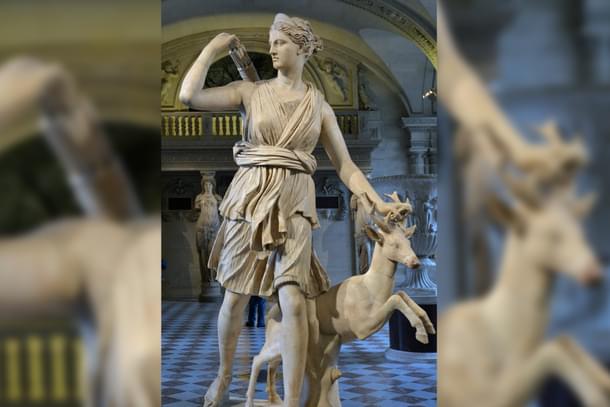
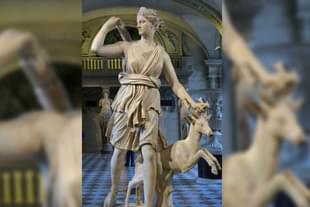
Demetrius, the silversmith looked at Her with devotion and sadness. She had flown through his fingers and tools. She stood with abundant grace. Neither vengeful nor jealous She came to the call of every woman. She contained in Her the gifts of all plant life and the diversity of all animal life. Containing all and contained in all, She was beauty and auspiciousness combined.
She had been venerated for generations in his family line. But for how long more?
The roaring sound outside was on the rise. ‘Whore of Babylon’ ‘Mistress of the devil’ ‘Destroy Her images for She is the false whore of hell!’
Demetrius of Ephesus stood up determined. He went before the fanatical crowd. He faced the mob and said in a voice filled with emotion and yet with unwavering steeliness, ‘She is my Mother. She is our Mother.’
She was the Goddess of the wild beasts. She was also the Goddess of the human settlements. She became the fine bonds which still united the human species with the animal kingdom, from which the humanity considered itself separate. Thus She was the very symbiosis. She was the huntress. She was the sanctuary. Humans and other non-human animals joined in Her worship. She was also the Goddess of child birth.
She was Artemis, the Huntress-the Goddess of the wild beasts.
Long before She was called Artemis, in the bronze age Aegean religion, spanning from around 3000 to 1000 BCE, centred mainly on the island of Crete and extending up to western Anatolia of modern Turkey, She existed in the tradition of an ancient Goddess adorned by all animal species, including humans.
The wall frescoes from the region, like the one from Cycladic island of Thera, now preserved in various museums, depict the Nature Goddess in different contexts.
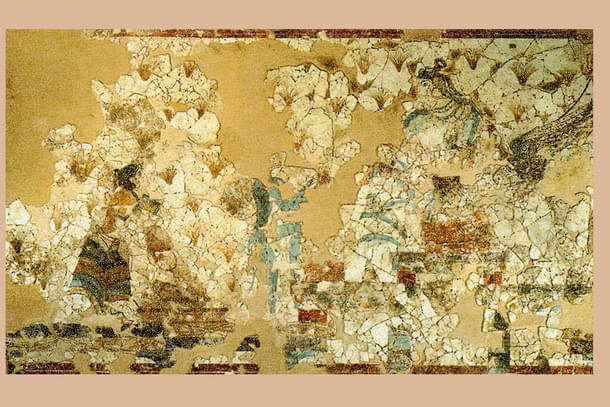
Common elements include adoring wild animals, offerings of crocus flowers, and maidens as worshippers, reflecting a priestess tradition. Over time, the sacred features of Mediterranean Goddesses merged with the Aegean Goddess of Nature. She was winged, holding animals symmetrically in her hands or adorned by them on both sides, later known as Potnia Theron – the Lady of the Wild Beasts.
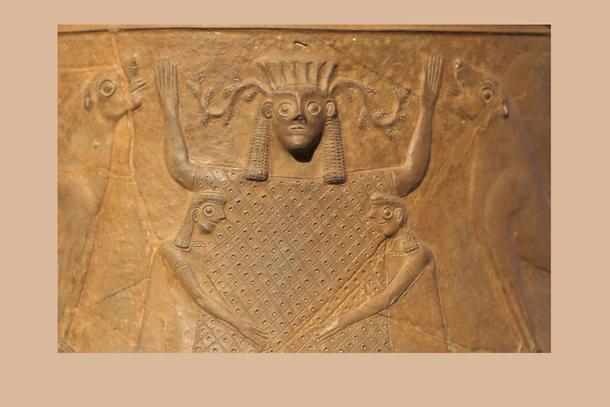
In Artemis all these streams would merge. Still, She is a mystery.
The study of Artemis’s religious role in Greek society is often overshadowed by the dominant Zeus-centric interpretation of Greek mythology. This bias may stem from an unconscious alignment within academia, where the male-centred Zeus pantheon resonates with the male-centred Christian pantheon of the Triune god and various saints.
While the dominance of Zeus in ancient Greek religion and mythology is undeniable, this focus frequently eclipses the significant reverence and influence that Artemis held.
Yet, Her temple was one of the wonders of the ancient Western civilisation. It was in the city of Ephesus.
A very good indication of Her quiet, all pervasive diverse role is shown in the hymn to Artemis written by Callimachus, an ancient Greek poet of third century BCE. Here, the poet points out that She was the huntress by nature – even as a child in the lap of Zeus. She also is of various names, which in turn is a boon she would get from Zeus.
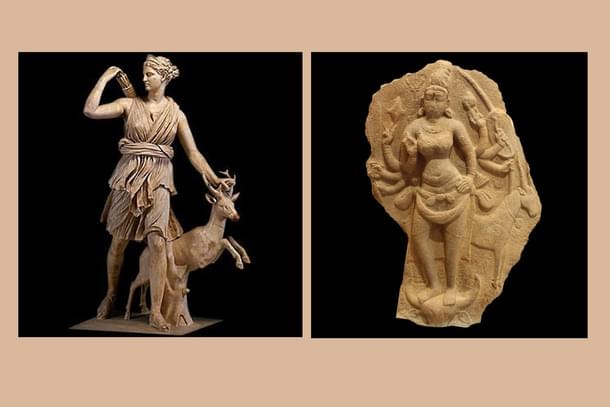
She was the huntress and She was the Goddess of the mountains. Yet she would have to visit the cities of men. Why? In the hymn of Callimachus, Artemis states that when She was born, Moirai or the Fates, three Goddesses who weave and tailor the destiny namely, Clotho – who brings beings into existence, Lachesis who determines the length of life thread and Atropos who terminates the life thread, decreed upon Artemis to assist the women who cry in pain during child birth. Why? Because when Artemis was in the womb of Her mother, she caused no pain nor was there pain during the labour.
This mythological element is quite significant.
Unlike the God who cursed humanity with pain in labour, here the Goddess brings the goodness and comfort of Her own divine birth to the suffering humanity to help them deliver children without pain.
There are two elements here: One, She comes to the calls of the pain of the women. Two. She becomes the connection through labor and delivery, the most important and traumatic initial transition any human undergoes. Cut off from the umbilical cord, the child becomes an individual, just as humanity cuts itself off from the natural world through human settlements.
Goddess Artemis, in Her enigmatic duality, transcends that duality. She presides over both the untamed wilderness and human abodes. Thus, while She liberates the physical umbilical cord from the biological mother, She transforms into the spiritual umbilical cord of the biosphere, from which humanity seems to have estranged itself.
Even during the Common Era, Her worship flourished. A particular statue of Her had become famous. Here She could be seen with multiple hanging fruit like projections on Her upper body and animals in Her lower body. What is a dress decoration for the Western scholarly perspective, for a Hindu this could well be the garment as well as Vishwarupa – the universal form- of the Goddess Artemis, containing in Her all flora and fauna of the planet.
Majestic she stood.
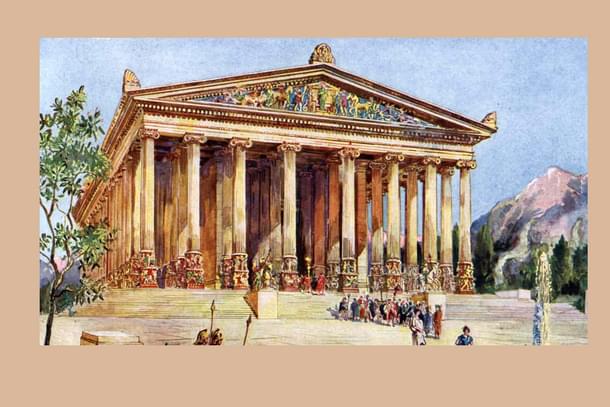
In the ancient city of Ephesus, where her temple was renowned throughout the Greek and Roman world, silversmiths crafted and sold sacred images of the Goddess Artemis. However, a new religious movement, centred around a male child god, began to spread through the town. This new cult, fervently preached by the recently converted Paul, denounced the handcrafted sacred idols as sinful.
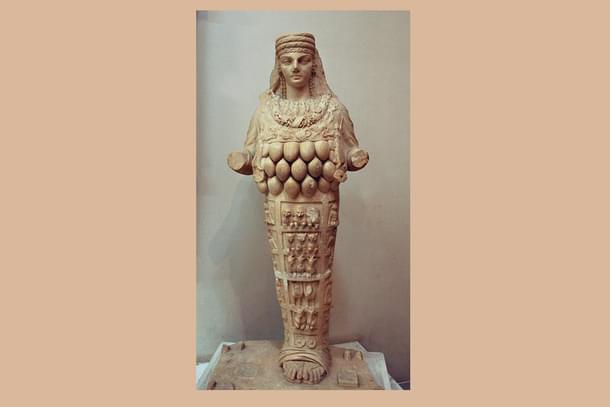
The silversmiths, led by Demetrius, were deeply troubled by this shift. Their livelihoods were threatened as the populace increasingly embraced the new doctrine, turning away from the veneration of the Great Mother. This tension culminated in a significant uproar, vividly recounted in the Christian text, Acts 19.
The craftsmen’s protest highlighted the clash between the enduring tradition of the Goddess and the burgeoning influence of the new faith.
Soon the temple would be in ruin and mutilated, She would stand in exhibitions.
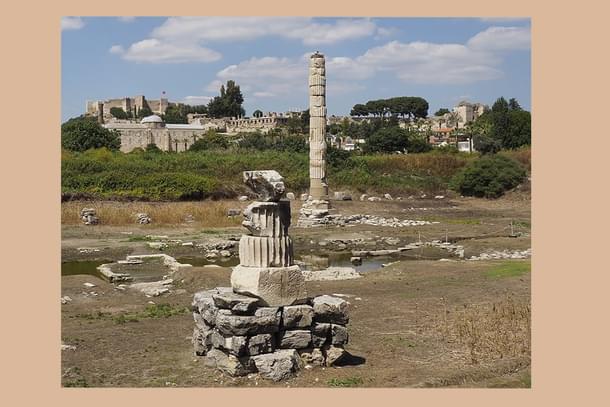
In another land and in even present times, the Goddess of all animals, the Goddess with tiger and lion, the Goddess of the Deer and Goddess who safeguards the women in child birth, is alive.
She is adorned by not just flora and fauna but all life forms – from Devas and Ganas to humans. She presides over all of them. She is the Queen presiding the kolus of every home in India. Eight-years-old girls and eighty-year-old matriarchs of the households sing to the Goddess who as Durga has the lion as the mount. She is the Goddess of the mountain – Vindhyachala nivasini. She as Sashti is the Goddess of cats and child birth. She is Artemis.
The Goddess lost in frescoes of Cycladic island of Thera is alive and adorned in the kolu of Hindu houses of southern India. Soul of Demetrius awaits in the West the return of Artemis, through Durga of the East.
Also read:
1. Navratri notes: Nammu, the forgotten Serpent-Sea Goddess from Sumeria
2. Navratri notes: Inanna, the Goddess of Life and War
3. Navratri notes: Maat, the Goddess of Cosmic Order, Breath of Life, and Justice





